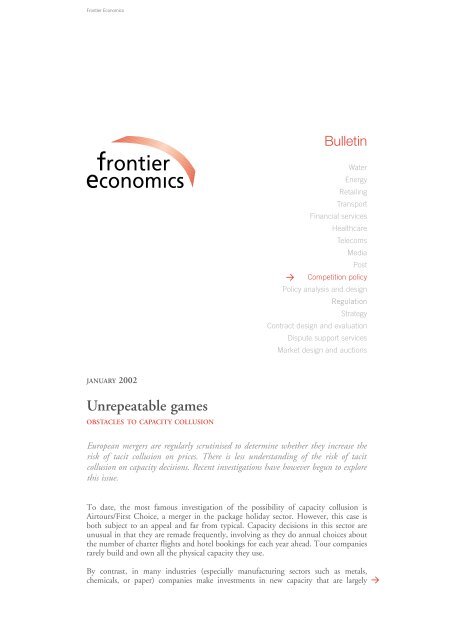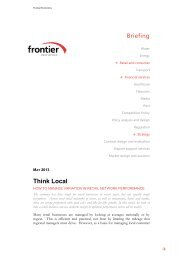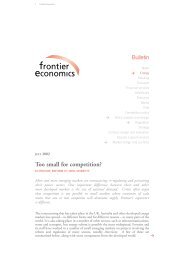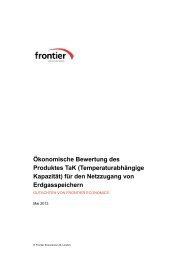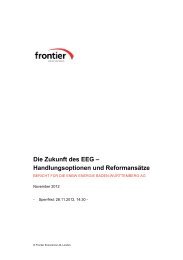unrepeatable games.pdf - Frontier Economics
unrepeatable games.pdf - Frontier Economics
unrepeatable games.pdf - Frontier Economics
You also want an ePaper? Increase the reach of your titles
YUMPU automatically turns print PDFs into web optimized ePapers that Google loves.
<strong>Frontier</strong> <strong>Economics</strong><br />
JANUARY 2002<br />
Unrepeatable <strong>games</strong><br />
OBSTACLES TO CAPACITY COLLUSION<br />
Bulletin<br />
Water<br />
Energy<br />
Retailing<br />
Transport<br />
Financial services<br />
Healthcare<br />
Telecoms<br />
Media<br />
Post<br />
> Competition policy<br />
Policy analysis and design<br />
Regulation<br />
Strategy<br />
Contract design and evaluation<br />
Dispute support services<br />
Market design and auctions<br />
European mergers are regularly scrutinised to determine whether they increase the<br />
risk of tacit collusion on prices. There is less understanding of the risk of tacit<br />
collusion on capacity decisions. Recent investigations have however begun to explore<br />
this issue.<br />
To date, the most famous investigation of the possibility of capacity collusion is<br />
Airtours/First Choice, a merger in the package holiday sector. However, this case is<br />
both subject to an appeal and far from typical. Capacity decisions in this sector are<br />
unusual in that they are remade frequently, involving as they do annual choices about<br />
the number of charter flights and hotel bookings for each year ahead. Tour companies<br />
rarely build and own all the physical capacity they use.<br />
By contrast, in many industries (especially manufacturing sectors such as metals,<br />
chemicals, or paper) companies make investments in new capacity that are largely >
2 <strong>Frontier</strong> <strong>Economics</strong> | January 2002<br />
irreversible (the costs are sunk), generally lumpy (each plant accounting for a significant<br />
percentage of total industry capacity), and usually durable (depreciating over a long<br />
period). Capacity tends to be a key strategic variable in such situations. In the short term,<br />
capacity levels will be fixed, since new investments take time – often years – to come on<br />
stream. Hence market prices will be driven by the interaction between demand and<br />
current capacity. In the long term, firms compete to introduce new capacity as technological<br />
change or demand growth make it profitable. These characteristics, taken together,<br />
imply that new investments will be built relatively infrequently and are rival: if one firm<br />
builds a new plant, this profitable opportunity cannot be exploited by another firm.<br />
Mergers between large suppliers in such markets may raise collective dominance<br />
concerns. In recent cases, the European Commission has considered two possible ways<br />
in which a group of firms might tacitly collude:<br />
• by co-ordinating investment, in order to limit the introduction of new capacity into<br />
the marketplace, the aim being to raise the level of average prices in the long-run;<br />
• by co-ordinating output downtimes (i.e. capacity utilisation rates), in order to<br />
support short-run prices during periods of limited demand.<br />
This bulletin focuses on the first of these possibilities. It explores the characteristics of<br />
capacity investment in such industries, and their implications for the structure of any<br />
tacitly collusive agreements, as well as their chances of success.<br />
DOING THE TWO-STEP<br />
Would a merger allow a group of large suppliers to restrict the level of new capacity<br />
coming on to the market, in order to drive up prices? In practice, two steps would be<br />
needed to any such an arrangement.<br />
An initial “restraint period”: Starting from the current level of capacity, the large<br />
suppliers would need to abstain from new investment until the desired (monopoly)<br />
level of industry capacity is reached.<br />
A subsequent “investment rota” period: The monopoly capacity level will be a<br />
moving target if demand or technology change over time. As a result, the large<br />
suppliers would need to decide who would undertake the necessary extra<br />
investment, for example by agreeing that they should take turns.<br />
In reaching a view on the likely success of any such co-ordinated arrangement, there are<br />
a number of economic factors to be explored. These relate to two main issues.<br />
Agreement. Would the large suppliers agree to form a co-ordinated arrangement?<br />
Are the incentives amongst large suppliers sufficiently aligned for consensus to be<br />
reached on the appropriate levels of key variables? Would they have the ability to do<br />
so tacitly?<br />
Enforcement. Would the large suppliers be able to enforce the collusive arrangement<br />
in the face of the individual incentives to cheat? Could a sufficiently powerful<br />
punishment strategy be developed? Would the threat to carry out that punishment<br />
strategy be credible?<br />
These two issues are now discussed in more detail, with particular reference to the<br />
characteristics of new capacity.<br />
ONE LUMP OR TWO?<br />
In developing a co-ordinated agreement, the firms would need to ensure that the details<br />
of that agreement are clear to all parties, and that all parties would prefer to join in<br />
rather than go it alone. Agreements would have to cover a number of aspects, including<br />
the duration of the restraint period, the order of the investment rota, and how to alter<br />
the arrangement to take account of responses by fringe firms or changes in demand<br />
Unrepeatable <strong>games</strong>
3 <strong>Frontier</strong> <strong>Economics</strong> | January 2002<br />
conditions. This task would be made more complex by asymmetries in strategies and<br />
incentives amongst the large suppliers, as then each firm may disagree on the<br />
appropriate numbers for key variables.<br />
Agreement on these details could only be developed tacitly through regular market<br />
interactions between firms. These interactions may occur either through actual market<br />
behaviour (e.g. price, output or capacity decisions) or through the signalling of future<br />
behaviour (e.g. announcements relating to future plans). Such interactions are needed<br />
if patterns of behaviour and mutual understanding are to be developed. Attempts to<br />
achieve tacit collusion with respect to capacity presents particular difficulties.<br />
Lumpiness creates asymmetries. If it were possible to increase capacity by small<br />
increments, each firm could agree to do so on a regular basis. However, since the<br />
capacity created by building new plants is normally substantial, and investments are<br />
rival, permission to introduce each ‘lump’ would need to be allocated amongst the<br />
large suppliers in the investment rota phase. Consequently, the first in line would<br />
benefit from having an increased market share now; the last supplier would need to<br />
be content with “jam tomorrow”. Since the rota might need to set long gaps –<br />
perhaps many years – between investments, there would be a substantial difference<br />
between the present value of profits of the firm that goes first in the rota and the<br />
firm that goes last.<br />
Market interactions are rare. Since capacity investments are lumpy, market<br />
interactions may only occur on a yearly basis, or even less frequently. The playing<br />
of a “repeated game”, which enables firms to develop a tacit understanding of each<br />
others’ proposed strategies, is not possible.<br />
Signalling ability is limited. Market conditions may change regularly, and to be<br />
optimal, the co-ordinated arrangement between suppliers would need to alter in<br />
response. Such flexibility is not easy to achieve without confusing the signals. For<br />
example, how would one large supplier respond to an increase in forecast market<br />
demand during the investment rota phase? From its point of view, the agreement<br />
should ideally accelerate the pace of new investment. However, since changes in the<br />
level of capacity are lumpy, costly, and irreversible, it would be necessary to signal<br />
this belief in ways that would not lead other large suppliers to suspect a deviation<br />
from the original agreement.<br />
These difficulties can be contrasted with those relating to pricing decisions, where<br />
incremental changes are usually feasible, market interactions are more frequent, and<br />
flexible responses are easier to achieve.<br />
THIS IS GOING TO HURT ME MORE THAN YOU<br />
All tacitly collusive arrangements have an internal tension: in the short term, the<br />
benefits to a firm from cheating on the agreement outweigh the benefit from sticking<br />
to that agreement. To sustain a tacit agreement, therefore, a punishment mechanism is<br />
required, which ensures that the future benefits from sticking to the agreement<br />
outweigh the short-term benefits from deviation.<br />
Besides hurting the deviator, retribution will also hurt the would-be punishers. A welldesigned<br />
punishment mechanism must therefore balance two requirements.<br />
The punishment must be powerful – that is, the deviator must suffer a substantial<br />
loss of profits.<br />
The punishment must also be credible – so that when faced with a deviation,<br />
punishers would indeed choose to inflict that punishment (at a cost to themselves)<br />
rather than accommodate the deviation.<br />
Economic theory suggests that the optimal punishment strategy is one that involves a<br />
Unrepeatable <strong>games</strong>
4 <strong>Frontier</strong> <strong>Economics</strong> | January 2002<br />
“short, sharp shock”: a short period of severe punishment, with the punishers often<br />
operating below the competitive level, followed by a swift return to the collusive<br />
arrangement. In this way, deviators are punished, whilst punishers themselves can<br />
foresee the prospect of a return to good times.<br />
In the case of price collusion, optimal punishment strategies might typically entail a<br />
temporary price war: when the deviator cuts prices, the punishers cut harder. In the case<br />
of capacity collusion, a deviation might involve a firm “building out of turn” during the<br />
investment rota, and an appropriate response might therefore seem to be that all other<br />
firms also build new plant. This immediately illustrates the difficulties with respect to<br />
collusive arrangements on capacity as opposed to price.<br />
The set of credible punishments is smaller: Since investments are irreversible and<br />
long-lasting, “short sharp shocks” are ruled out. Any would-be punisher must face<br />
the prospect that the punishment – and hence the cost to itself – will last for a long<br />
time. Moreover, punishers will not be inclined to do more than return to the<br />
competitive capacity level – in other words, to fill the “capacity gap” between the<br />
agreed monopoly level and the competitive level. Any greater punishment would<br />
not be credible, since punishers would be better off not enforcing it.<br />
The deviator can limit the size of the punishment: Once deviation has occurred, it<br />
is a fait accompli – the remaining firms cannot induce the deviator to remove its<br />
capacity as the investment is irreversible (the costs are sunk). If the deviator invests<br />
in enough new capacity to fill the “capacity gap” completely, the only possible<br />
response by the other large suppliers is a return to competitive investment behaviour<br />
over time. Active counter-investment is ruled out. The irreversibility of new capacity<br />
investments therefore gives the deviator a first-mover advantage.<br />
Any tacit agreement on new capacity decisions would therefore be on a knife-edge, and<br />
restoring the collusive arrangement after any deviation would take many years. Once<br />
again, the opportunity to play a “repeated game”, so, necessary for successful tacit<br />
collusion, is essentially lacking in the field of investment.<br />
CONCLUSION<br />
Tacit collusion theories tend to be underpinned by the assumption that players are<br />
engaging in <strong>games</strong> with two key features: that market interactions are frequent and<br />
readily reversible. These features are relevant to both the formation and the<br />
enforcement of any tacitly collusive arrangement.<br />
In order to form an agreement, frequent interaction may be required to develop a<br />
mutual understanding of each others’ strategies. Reversibility may be necessary to<br />
provide the flexibility to respond to changes in the market environment.<br />
In order to enforce an agreement, frequent interaction may be required to reinforce<br />
the future benefits of collusion compared with the short-term benefits of deviation.<br />
Reversibility may be required to restore an agreement after deviation and<br />
punishment have occurred, sufficiently quickly.<br />
The characteristics of capacity investments in many (notably manufacturing) industries –<br />
in particular, their irreversibility, lumpiness and durability – are such that neither of these<br />
features is prevalent. This greatly decreases the likelihood of effective capacity collusion.<br />
CONTACT<br />
Zoltan Biro zoltan.biro@frontier-economics.com<br />
Chris Newton chris.newton@frontier-economics.com<br />
David Parker david.parker@frontier-economics.com<br />
<strong>Frontier</strong> <strong>Economics</strong>, 150 Holborn, London, EC1N 2NS UK<br />
BOSTON | LONDON | MELBOURNE<br />
www.frontier-economics.com


